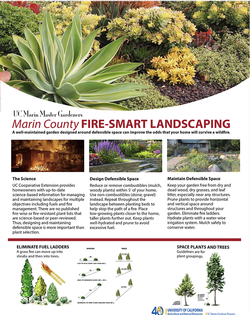Tips: Monthly Fire-smart Reminders
Feeling overwhelmed and need a place to start? Check out our monthly tips for actionable, affordable ways to reduce fuel on your property. Our fire-smart landscaping tips are a reminder to homeowners to plan and maintain their homes and landscapes with awareness of the threat of wildfires. Read on for this month's fire-smart tip!
JANUARY: Pruning and Thinning for Fire Safety
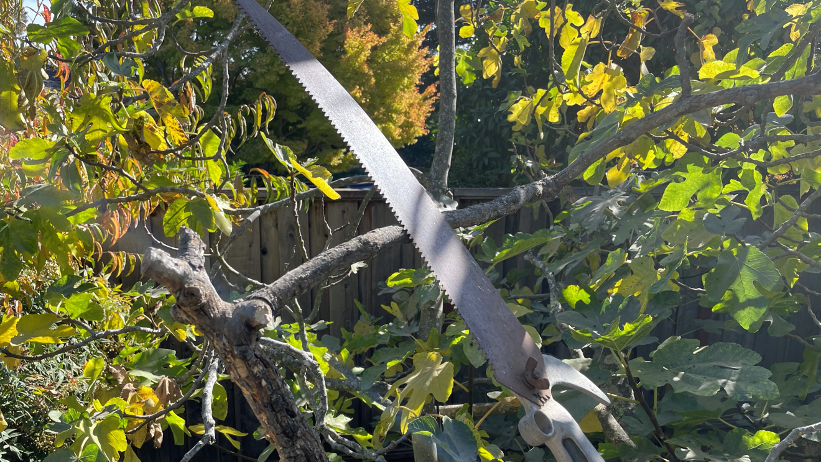
Winter is a great season to focus on pruning while trees are dormant (except apricot and cherry). When pruning for fire safety, prioritize Zone 0 (0-5 feet from home) and Zone 1 (5-30 feet from home).
Prune to remove dead and dying branches
Dead and dying branches are highly flammable and pose a hazard. Prune them regularly to prevent them from accumulating and creating fuel ladders that can carry fire to the crowns of trees.
Prune and thin to increase space between trees and shrubs
Thinning out dense areas of shrubs and trees reduces the amount of continuous fuel for fire. Proper spacing helps prevent fire from spreading quickly and creates defensible space for firefighters. For more information about spacing, see our November tips: Plant Spacing in a Fire-Smart Landscape.
Additional tips:
- Avoid topping trees as this weakens their structure and encourages dense, twiggy growth that is highly flammable
- Remove branches within 10 feet of your chimney
- Consider removing branches that overhang your roof to minimize plant debris, but not to the detriment of the tree’s health
- For more information about healthy pruning techniques, click here
Remember, fire-smart pruning is an ongoing process. Regularly monitor your landscape and prune as needed to maintain defensible space around your home.
FEBRUARY: Trees & Shrubs - Consider Spacing
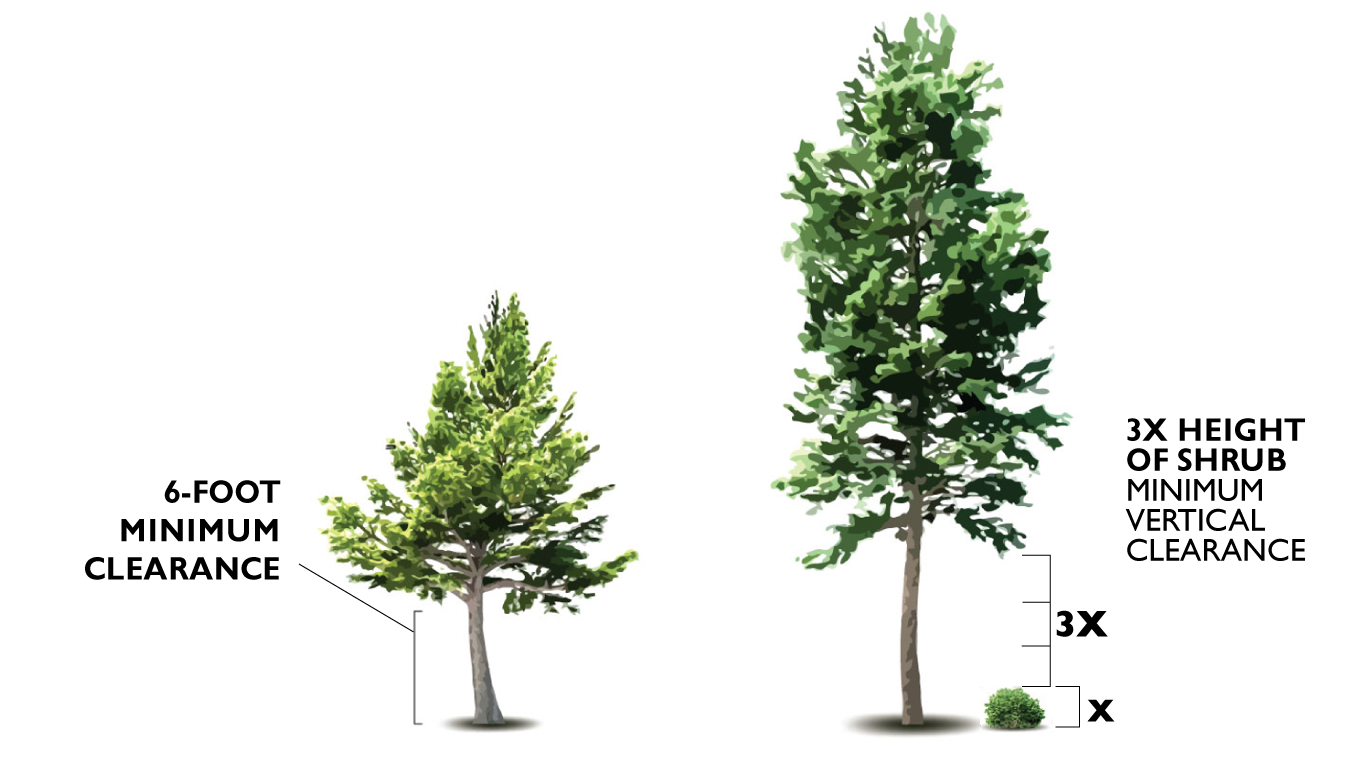
- Consider creating separation by increasing spacing between tree canopies while considering flat vs sloped terrain.
- Maintain vertical clearance of at least 3X the shrub’s height between the tops of shrubs and the bottom of the tree canopy. This can be done by pruning the shrub down, or pruning smaller, easily ignitable tree branches up, or both.
- Remove dead trees.
- Plant spacing, size control and maintenance are more important than type of plant.
MARCH: Remove & Replace Invasive Plants
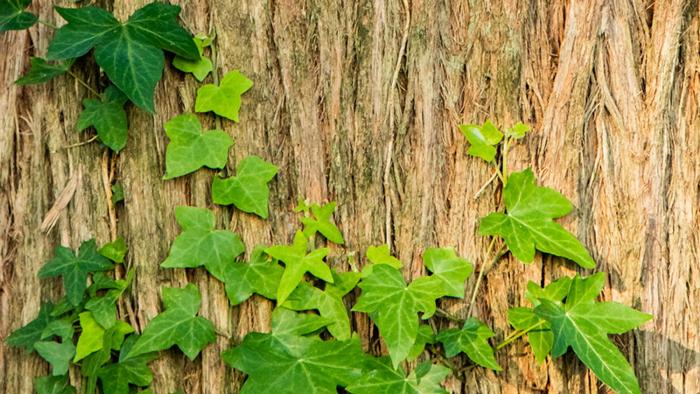
Invasive plants spread quickly, use precious water, and add considerable amounts of fuel for fire.
- Remove invasive plants such as ivy, broom, and pampas grass. Learn more about invasive plants here.
- Replace with California natives, pollinator plants, or low-water use plants. Learn more about native plants here.
- When replacing invasives with new plants, use appropriate plant spacing based on how close you are planting to your home and other structures. Learn more about plant spacing here.
If you decide not to replace an invasive plant by planting a new plant in its place, use an appropriate mulch to cover the bare spot to prevent weeds and other opportunistic plants from establishing in this area. Learn more about mulch here.
APRIL: Assessing Fire Risk to Your Property
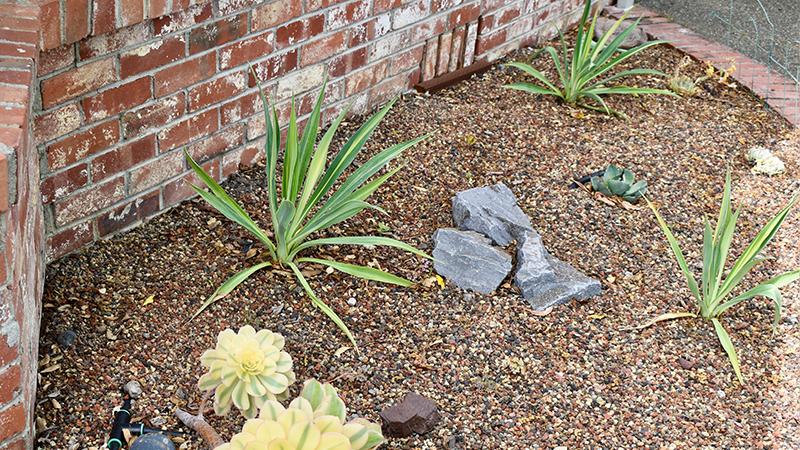
When you evaluate your fire risk, think lean, clean, and green.
Lean landscapes
- Plant with appropriate spacing between plants. Learn more about plant spacing
- Separate clusters of plants from each other with pathways of non-combustible materials.
Clean landscapes
- Remove dried grass, weeds, dead branches, and all other dead vegetation.
- Check gutters, roofs, eaves, vents, chimneys, and under decks for leaf and needle litter.
- Thin and reduce branches from dense tree canopies. Learn more about prunning
Green landscapes
- Keep your plants healthy with proper irrigation, and check your irrigation system regularly for leaks or malfunctions. Learn more about irrigation
- Apply compost and mulches to help stabilize soil temperature and prevent evaporation, keeping soil moist and healthy. Learn more about fire-smart mulches
MAY: Lean & Clean Exit Routes
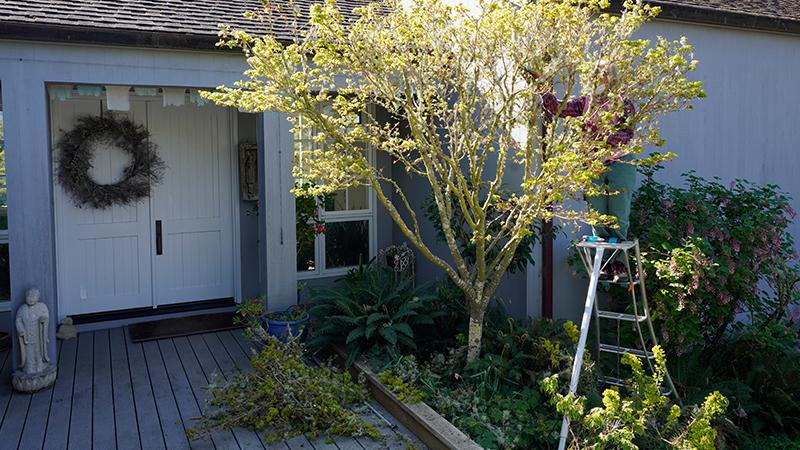
In case of a fire, know your best escape routes and keep yourself, your family, and firefighters safe by maintaining a clean and lean landscape around your property’s exit routes.
- Keep vegetation around your exit routes pruned for clearance and hydrated for optimal plant health.
- Remove combustible materials such as jute door mats, wood planters and furniture, etc. from your exits.
- Remove dead plant material and debris from exit routes, and all plant material growing near doors and windows.
- Replace wood gates, arbors, or trellises near exit routes with metal.
- Have evacuation signs ready to post at home exits. These signs will inform fire personnel that you have left the property. Check with your local fire department for signs.
JUNE: Clean up Zone Zero - Within 5 Feet of Your Home
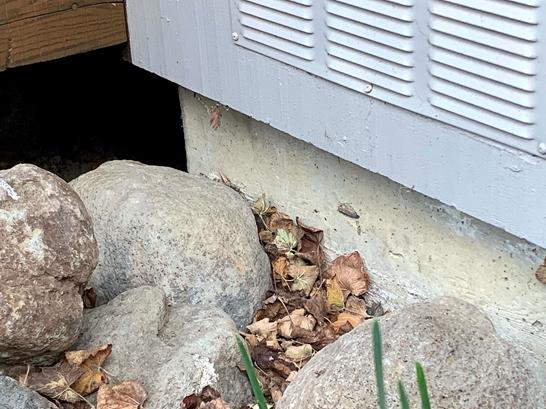
Zone 0 is the area within 5 feet of your home and is a critical area to keep clean of any combustible materials in order to better protect your home from fire.
- Remove dead or dry leaves and pine needles from your yard, roof, and rain gutters.
- Clean-up areas where wind eddies deposit leaf and plant litter along the perimeter of your home.
- Replace plants within 5 feet of the home with potted plants that are easy to move away from the home during a fire threat.
- Remove combustible mulch within 5 feet of the home and move it to another location in your garden. Click here to learn more about mulch guidelines for a fire-smart landscape
- Move common combustible fire hazards away from the area immediately surrounding your home including brooms, rakes, plastic waste bins, wood furniture, furniture cushions, wood piles, and natural fiber door mats. Click here to learn more about how to manage these common fire hazards
JULY: Water Wise Strategies
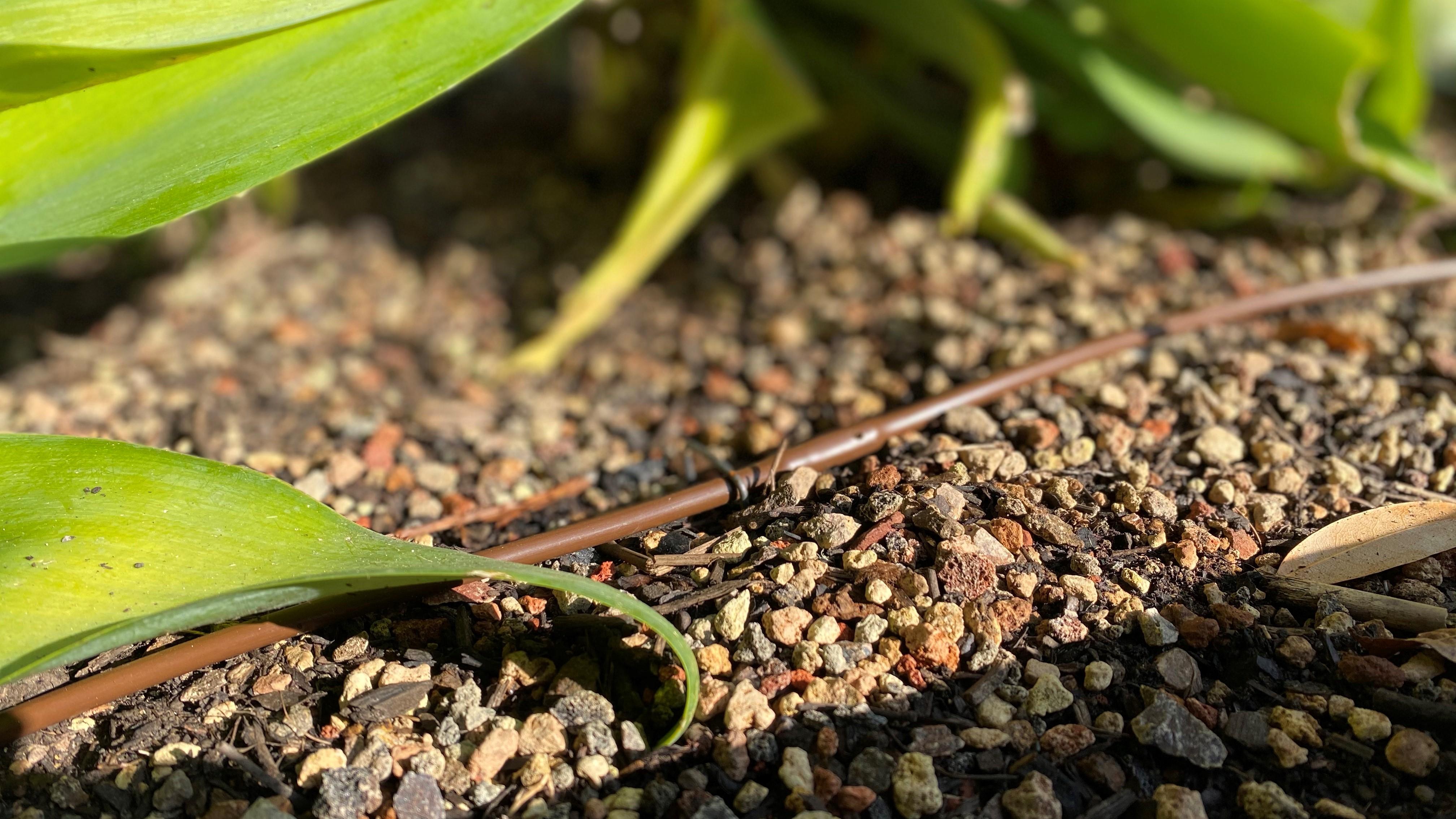
Maintaining healthy plants through the summer is a fire-smart strategy. Well-hydrated plants have been found to be more resistant to embers and ignitions. Use these important fire-smart & water-wise landscaping strategies:
- Help your soil maintain moisture by using compost and appropriate fire-smart mulches outside of Zone 0.
- Learn how much water your plants need and give them the right amount. This will help keep your plants healthy and happy.
- Water your plants in the early morning, applying water to the base of the plant within its dripline.
- OVER IRRIGATION IS COMMON. Consider using flow meters, soaker hoses, drip irrigation, and irrigation controllers for more efficient administration and monitoring.
- Use fertilizers sparingly. They make plants grow quickly and require more water to support new growth.
- Avoid planting new plants during the hot summer months. They need more water to establish themselves and thrive.
- Remove invasive plants and weeds which take water from other plants.
- Reduce the size of your thirsty lawn.
- On days with Red Flag warnings, avoid changing your irrigation schedule or using more water. Using excessive water for irrigation reduces the water available to our fire personnel.
Learn more about irrigation here.
Learn about prioritizing plants for water conservation here.
AUGUST: Maintaining a Fire-Smart Zone 0

As we get deeper into fire season, now is a good time to assess your landscape for immediate fire risk and take action. When evaluating fire risk, think lean, clean, and green, and start at the house and work out.
With these principles in mind, we’ll focus on Zone 0, the first 5 feet surrounding your home. Next month we will focus on Zone 1.
A Clean Zone 0
Remove any combustible materials that are within 5 feet of your home. This includes (but not limited to) wood-based mulches, leaf litter and woody or dead plant materials, wood piles, and furniture. Clean under raised decks and in wind eddies that trap debris.
Also, remove any plant debris from your roof and gutters.
A Lean & Green Zone 0
It is best practice to remove plants from Zone 0. However, if you have plants in this area, consider removing woody plants, keeping plants low to the ground, and keeping plants away from windows, doors, and combustible siding. Having ample space between plants will help slow the spread of fire, and properly irrigate your plants to keep your plants green and healthy through the summer.
Ongoing maintenance of Zone 0 is critical.
SEPTEMBER: Maintaining a Fire-Smart Zone 1
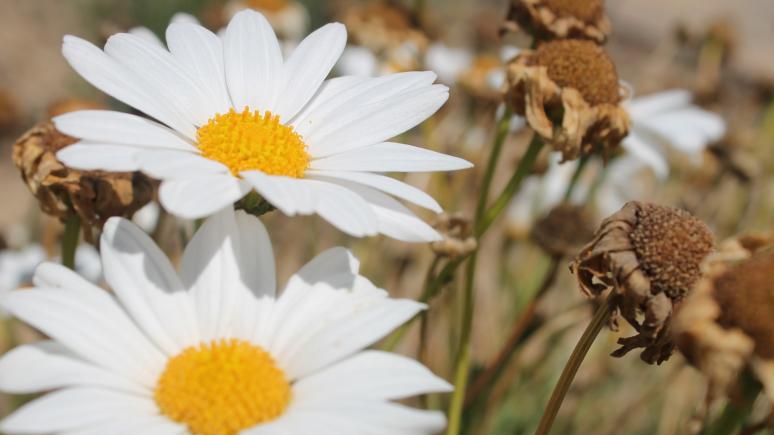
After cleaning Zone 0 (0-5 feet from home) of any combustible materials (see August’s Fire-Smart tips), this month we’ll focus on applying the Fire-Smart Landscaping principles of “think lean, clean, and green”, and “start at the house and work out” to Zone 1 (5-30 feet from home).
A Clean Zone 1
Remove any dead vegetation and dry grasses from the landscape to reduce potential fuel. Regularly prune trees and shrubs to remove dead branches, and remove dead flowers to reduce flammable material from your landscape.
A Lean & Green Zone 1
Regularly inspect plants for drought stress and water appropriately to keep plants healthy. Plants will need less water as we enter cooler weather in the fall months.
Prune trees and shrubs to reduce canopies' density and maintain appropriate space between plants to slow down the spread of fire from plant to plant. Remove low-hanging branches from trees to create space between lower vegetation and reduce the risk of ladder fuels.
And remember, ongoing maintenance of Zone 0 (0-5 feet from home) is critical during fire season.
OCTOBER: Fire-smart Plant Considerations
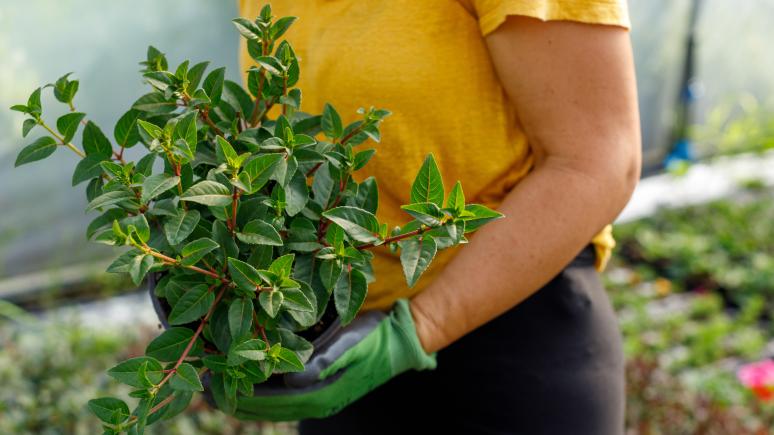
There are no fire-resistant plants since all plants can burn. But there are aspects to consider when selecting plants to include in your fire-smart landscape. Plant spacing, size, and maintenance are important considerations.
Consider:
- Plants that have a higher moisture content, lower resin or sap content, and less volatile oils.
- Low-growing plants and plants that don’t produce excessive amounts of dry, combustible vegetation that can act as fuel for fires.
- California native plants that are well adapted to your climate and ecosystem which will be more likely to thrive without excessive watering and maintenance, reducing fire risk.
- Horizontal and vertical spacing between plants and hardscape features that separate plant groupings to break up the path of fire.
Avoid plants that:
- Tend to build up dead thatch inside or under a green surface layer.
- Produce and shed excessive dead, dry, or fine debris.
- Create fire ladders such as vines or shrubs that grow beneath trees and create vertical pathways for fire to climb.
- Are Invasive.
NOVEMBER: Plant Spacing in a Fire-smart Landscape

When considering plant spacing, you need to be mindful of how close the plants are to structures, the mature size of the plants, the steepness of slopes, and the vertical and horizontal spacing of plants.
Horizontal spacing:
- It is ideal to remove all plants within 5 feet of structures.
- Plant density can increase the further away from structures you get.
- Separate groups of plants with hardscaping to help slow down or prevent the spread of fire.
- On a mild slope (0-20% slope), space trees at least 10 feet apart from their dripline and space shrubs 2x their height from each other.
- On a medium slope (20-40%), space trees at least 20 feet apart and shrubs 4x their height.
- On a steep slope (over 40%), space trees at least 30 feet apart and shrubs 6x their height.
- Avoid planting trees in rows or hedges.
Vertical spacing:
- Remove tree branches that are within 6 feet from the ground on trees that are 18 feet or taller.
- If shrubs are under a tree, maintain a vertical clearance of 3x the shrub’s height between the top of the shrub to the lowest branch of the tree.
- When creating vertical space under trees, prioritize the tree's health by ensuring that the upper two-thirds of the tree has branches.
DECEMBER: Planning Your 3 Defensible Zones for Fire Safety
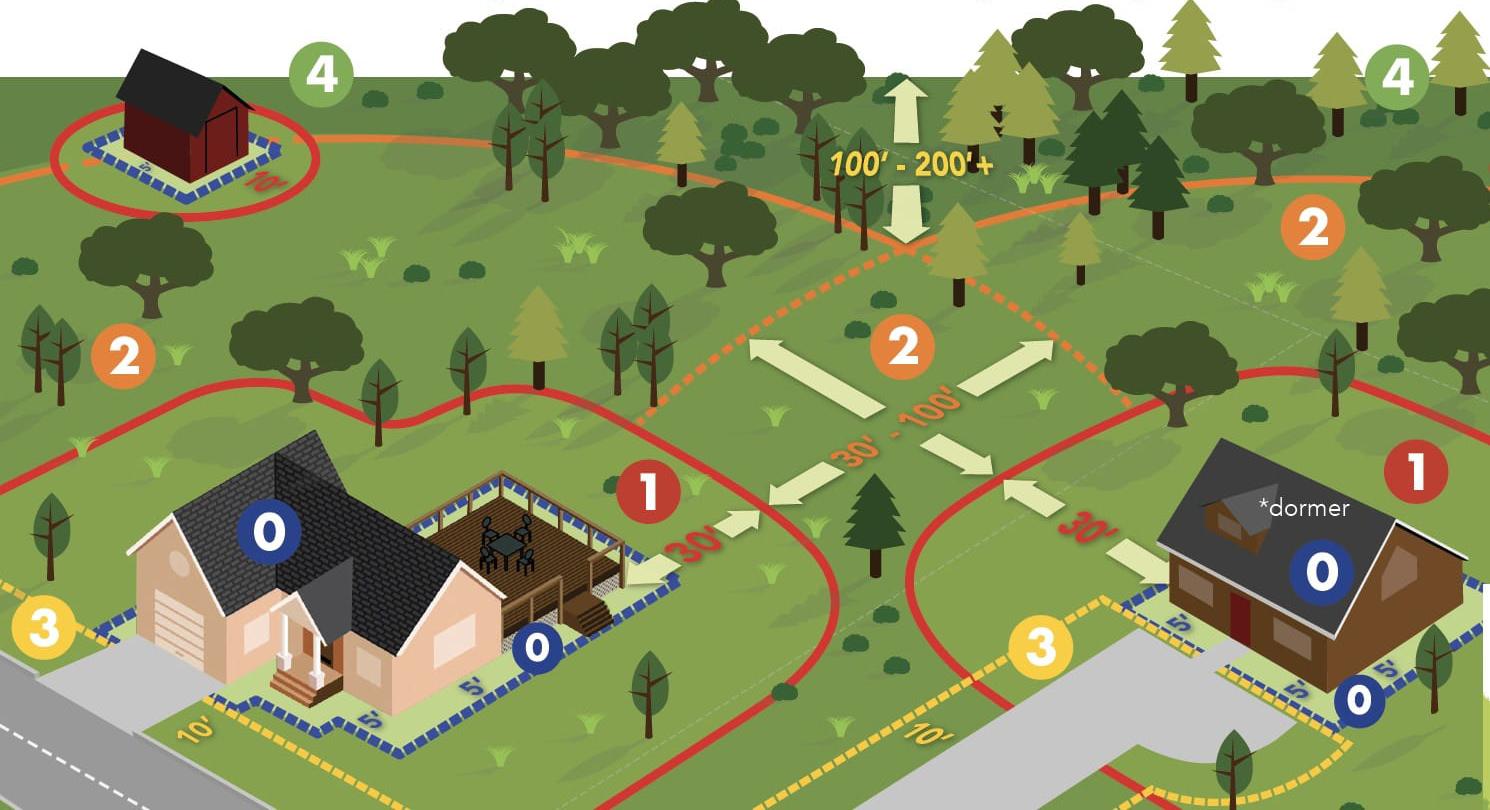
When planning your fire-smart landscape, start from the home and work your way out. The first 5 feet from your home is the most critical area.
Zone 0 – 0 to 5 feet from the house
Objective: create a fire-resistant barrier around any buildings by minimizing combustible materials.
- Use non-combustible mulch and hardscaping such as concrete, brick, rocks, decomposed granite, and gravel
- Avoid planting near windows
Zone 1 – 5 to 30 feet from the house
Objective: Reduce heat and movement of flame by creating a “lean and clean” environment.
- Allow for ample plant spacing to slow the spread of flames
- Plant low-growing and well-irrigated plants closer to the home and larger shrubs and trees further away
- Break up mulched areas with hardscaping
Zone 2 – 30 to 100 feet from the house
Objective: Decrease the energy and speed of a fire by eliminating plant density.
- Allow ample plant spacing both vertically and horizontally to slow down the spread of fire
- You may need to collaborate with your neighbors to plan out this defensible zone

